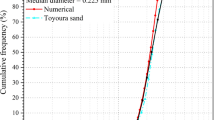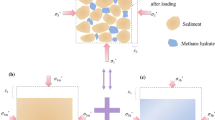Abstract
The mechanical behaviors of methane hydrate-bearing sands (MHBS) are largely affected by the presence of methane hydrate, temperature, and pore pressure. In this study, we present a simple hypoplastic model for MHBS. Methane hydrate saturation is included as a state parameter affecting the mechanical behaviors of MHBS. A new phase parameter is introduced to account for the coupled effects of temperature and pore pressure on the mechanical behaviors of MHBS. The phase parameter can be determined by a simple function of temperature and pore pressure. Comparison of the predictions with experiments shows that the model is able to capture the salient behaviors of MHBS.



















Similar content being viewed by others
References
Boswell R (2009) Is gas hydrate energy within reach? Science 325(5943):957–958
Cha MJ, Hu Y, Sum AK (2016) Methane hydrate phase equilibria for systems containing NaCl, KCl, and NH4Cl. Fluid Phase Equilib 413:2–9
Chaouachi M, Falenty A, Sell K, Enzmann F, Kersten M, Haberthür D, Kuhs WF (2015) Microstructural evolution of gas hydrates in sedimentary matrices observed with synchrotron X-ray computed tomographic microscopy. Geochem Geophys Geosyst 16(6):1711–1722
Choi JH, Dai S, Lin JS, Seol Y (2018) Multistage triaxial tests on laboratory-formed methane hydrate-bearing sediments. J Geophys Res Solid Earth 123(5):3347–3357
Dong L, Li YL, Liao HL, Liu CL, Chen Q, Hu GW, Liu LL, Meng QG (2019) Strength estimation for hydrate-bearing sediments based on triaxial shearing tests. J Pet Sci Eng. https://doi.org/10.1016/j.petrol.2019.106478
Duan ZH, Li D, Chen YL, Sun R (2011) The influence of temperature, pressure, salinity and capillary force on the formation of methane hydrate. Geosci Front 2(2):125–135
Guo XG, Peng C, Wu W, Wang YQ (2016) A hypoplastic constitutive model for debris materials. Acta Geotech 11(6):1217–1229
Huang WX, Wu W, Sun DA, Sloan S (2006) A simple hypoplastic model for normally consolidated clay. Acta Geotech 1(1):15–27
Hyodo M, Li YH, Yoneda J, Nakata Y, Yoshimoto N, Nishimura A, Song YC (2013) Mechanical behavior of gas-saturated methane hydrate-bearing sediments. J Geophys Res Solid Earth 118(10):5185–5194
Hyodo M, Nakata Y, Yoshimoto N, Fukunaga M, Kubo K, Nanjo Y, Matsuo T, Hyde AFL, Nakamura K (2002) Triaxial compressive strength of methane hydrate. In: The Twelfth international offshore and polar engineering conference. International society of offshore and polar engineers
Hyodo M, Yoneda J, Yoshimoto N, Nakata Y (2013) Mechanical and dissociation properties of methane hydrate-bearing sand in deep seabed. Soils Found 53(2):299–314
Jager MD, Sloan ED (2001) The effect of pressure on methane hydration in pure water and sodium chloride solutions. Fluid Phase Equilib 185(1–2):89–99
Jiang MJ, Liu J, Shen ZF (2019) DEM simulation of grain-coating type methane hydrate bearing sediments along various stress paths. Eng Geol 261:105280
Jiang MJ, Shen ZF, Wu D (2018) CFD-DEM simulation of submarine landslide triggered by seismic loading in methane hydrate rich zone. Landslides 15(11):2227–2241
Jiang MJ, Zhu FY, Liu F, Utili S (2014) A bond contact model for methane hydrate-bearing sediments with interparticle cementation. Int J Numer Anal Methods Geomech 38(17):1823–1854
Klar A, Soga K, Ng MYA (2010) Coupled deformation-flow analysis for methane hydrate extraction. Géotechnique 60(10):765–776
Kolymbas D (1991) An outline of hypoplasticity. Arch Appl Mech 61(3):143–151
Lei L, Seol Y, Choi JH, Kneafsey TJ (2019) Pore habit of methane hydrate and its evolution in sediment matrix-laboratory visualization with phase-contrast micro-CT. Mar Pet Geol 104:451–467
Lin JS, Seol Y, Choi JH (2015) An SMP critical state model for methane hydrate-bearing sands. Int J Numer Anal Methods Geomech 39(9):969–987
Madhusudhan BN, Clayton CRI, Priest JA (2019) The effects of hydrate on the strength and stiffness of some sands. J Geophys Res Solid Earth 124(1):65–75
Maekawa T (2001) Equilibrium conditions for gas hydrates of methane and ethane mixtures in pure water and sodium chloride solution. Geochem J 35(1):59–66
Makogon TY, Sloan EDJ (1994) Phase equilibrium for methane hydrate from 190 to 262 K. J Chem Eng Data 39(2):351–353
Mašín D (2005) A hypoplastic constitutive model for clays. Int J Numer Anal Methods Geomech 29(4):311–336
Masui A, Haneda H, Ogata Y, Aoki K (2005) Effects of methane hydrate formation on shear strength of synthetic methane hydrate sediments. In: The fifteenth international offshore and polar engineering conference. International society of offshore and polar engineers
Miyazaki K, Tenma N, Aoki K, Yamaguchi T (2012) A nonlinear elastic model for triaxial compressive properties of artificial methane-hydrate-bearing sediment samples. Energies 5(10):4057–4075
Nixon MF, Grozic JLH (2007) Submarine slope failure due to gas hydrate dissociation: a preliminary quantification. Can Geotech J 44(3):314–325
Ng CWW, Baghbanrezvan S, Kadlicek T, Zhou C (2019) A state-dependent constitutive model for methane hydrate-bearing sediments inside the stability region. Géotechnique 39(9):1–15
Pinkert S (2016) Rowes stress-dilatancy theory for hydrate-bearing sand. Int J Geomech 17(1):06016008
Pinkert S, Grozic JLH (2014) Prediction of the mechanical response of hydrate-bearing sands. J Geophys Res: Solid Earth 119(6):4695–4707
Pinkert S, Grozic JLH, Priest JA (2015) Strain-softening model for hydrate-bearing sands. Int J Geomech 15(6):04015007
Rutqvist J, Moridis GJ, Grover T, Collett T (2015) Geomechanical response of permafrost-associated hydrate deposits to depressurization-induced gas production. J Petrol Sci Eng 67(1–2):1–12
Sabil KM, Nashed O, Lal B, Ismail L, Japper-Jaafar A (2015) Experimental investigation on the dissociation conditions of methane hydrate in the presence of imidazolium-based ionic liquids. J Chem Thermodyn 84:7–13
Sánchez M, Gai XR, Santamarina JC (2017) A constitutive mechanical model for gas hydrate bearing sediments incorporating inelastic mechanisms. Comput Geotech 84:28–46
Sell K, Saenger EH, Falenty A, Chaouachi M, Haberthür D, Enzmann F, Kuhs WF, Kersten M (2016) On the path to the digital rock physics of gas hydrate-bearing sediments-processing of in situ synchrotron-tomography data. Solid Earth 7(4):1243–1258
Shen J, Chiu CF, Ng CWW, Lei GH, Xu J (2016) A state-dependent critical state model for methane hydrate-bearing sand. Comput Geotech 75:1–11
Shen ZF, Jiang MJ (2016) DEM simulation of bonded granular material. Part II. Extension to grain-coating type methane hydrate bearing sand. Comput Geotech 75:225–243
Soga K, Lee SL, Ng MYA, Klar A (2006) Characterisation and engineering properties of methane hydrate soils. Charact. Eng. Prop. Nat. Soils 4:2591–2642
Song YC, Zhu YM, Liu WG, Li YH, Lu Y, Shen ZT (2016) The effects of methane hydrate dissociation at different temperatures on the stability of porous sediments. J Petrol Sci Eng 147:77–86
Sun SC, Ye YG, Liu CL, Xiang FK, Ma Y (2011) Pt stability conditions of methane hydrate in sediment from south china sea. J Nat Gas Chem 20(5):531–536
Tang Y, Wu W, Yin KL, Wang S, Lei GP (2019) A hydro-mechanical coupled analysis of rainfall induced landslide using a hypoplastic constitutive model. Comput Geotech 112:284–292
Uchida S, Xie XG, Leung YF (2016) Role of critical state framework in understanding geomechanical behavior of methane hydrate-bearing sediments. J Geophys Res: Solid Earth 121(8):5580–5595
Waite WF, Santamarina JS, Cortes DD, Dugan B, Espinoza DN, Germaine J, Jang J, Jung JW, Kneafsey TJ, Shin H, Soga K, Winters WJ, Yun TS (2009) Physical properties of hydrate-bearing sediments. Rev Geophys. https://doi.org/10.1029/2008RG000279
Wang S, Wu W, Yin ZY, Peng C, He XZ (2018) Modelling the time-dependent behaviour of granular material with hypoplasticity. Int J Numer Anal Methods Geomech 42(12):1331–1345
Wang S, Wu W, Peng C, He XZ, Cui DS (2018) Numerical integration and FE implementation of a hypoplastic constitutive model. Acta Geotech 13(6):1265–1281
Wang S, Wu W, Zhang DC, Kim JR (2020) Extension of a basic hypoplastic model for overconsolidated clays. Comput Geotech 123:103486
Wu W, Bauer E (1994) A simple hypoplastic constitutive model for sand. Int J Numer Anal Methods Geomech 18(12):833–862
Wu W, Bauer E, Kolymbas D (1996) Hypoplastic constitutive model with critical state for granular materials. Mech Mater 23(1):45–69
Wu W, Kolymbas D (2000) Hypoplasticity then and now. In: Constitutive modelling of granular materials. Springer, Berlin, pp 57–105
Wu W, Lin J, Wang XT (2017) A basic hypoplastic constitutive model for sand. Acta Geotech 12(6):1373–1382
Wu W, Wang S, Xu GF, Qi JL, Zhang DC, Kim KR (2019) Numerical Simulation of a CAES Pile with Hypoplasticity. In: Wu W (ed) Desiderata Geotechnica. Springer, New York, pp 242–249
Xu GF, Wu W, Qi JL (2016) An extended hypoplastic constitutive model for frozen sand. Soils Found 56(4):704–711
Yan RT, Wei CF (2017) Constitutive model for gas hydrate-bearing soils considering hydrate occurrence habits. Int J Geomech 17(8):04017032
Yu F, Song Y, Liu W, Li Y, Lam W (2011) Analyses of stress strain behavior and constitutive model of artificial methane hydrate. J Petrol Sci Eng 77(2):183–188
Yun TS, Francisca FM, Santamarina JC, Ruppel C (2005) Compressional and shear wave velocities in uncemented sediment containing gas hydrate. Geophys Res Lett 32(10):L10609
Zhang XH, Lin J, Lu XB, Liu LL, Liu CL, Li MY, Su YW (2018) A hypoplastic model for gas hydrate-bearing sandy sediments. Int J Numer Anal Methods Geomech 42(7):931–942
Zhang XH, Lu XB, Shi YH, Xia Z, Liu WT (2015) Centrifuge experimental study on instability of seabed stratum caused by gas hydrate dissociation. Ocean Eng 105:1–9
Acknowledgements
The authors would like to acknowledge the National Natural Science Foundation of China with Grant Numbers 51639008 and 51890911, the H2020 Marie Skłodowska-Curie Actions RISE 2017 “HERCULES” with Grant number 778360, and “FRAMED” with Grant number 734485. The second author wishes to thank the Otto Pregl Foundation for Fundamental Geotechnical Research for financial support.
Author information
Authors and Affiliations
Corresponding authors
Additional information
Publisher's Note
Springer Nature remains neutral with regard to jurisdictional claims in published maps and institutional affiliations.
Appendices
Appendix 1
The complete hypoplastic equations for MHBS are summarized as follows:
where
In the above equations, \(\varvec{\sigma }_{\mathrm{T}}\) is the transformed stress tensor, \(\mathring{\varvec{\sigma }}\) is the Jaumann stress rate, \(\varvec{\sigma }\) is the Cauchy stress tensor, \({\dot{\varvec{\epsilon }}}\) is the stretching tensor, I is the second-order unit tensor, S is the internal variable, e is the current void ratio, \(e_{\mathrm{crt}}\) is the critical state void ratio, r is the stress ratio \(\Vert \varvec{\sigma }^* \Vert /({\text {tr}}\varvec{\sigma })\), \(L'\) is the phase state parameter, \(e_{\Gamma (\text {MH},L^\prime )}\) is the critical state void of MHBS at the atmospheric pressure, \(e_\Gamma\) is the critical state void of sand at the atmospheric pressure \(p_{\mathrm{a}}\), and \(p'\) is the effective mean stress. The parameters of the model are \(C_{1}\), \(C_{2}\), \(C_{3}\), \(C_{4}\), \(e_\Gamma\), \(\lambda\), \(\alpha\), \(\beta\), a, b, \(\xi\), \(\chi _1\), \(\chi _2\), and \(L'\).
Appendix 2
The parameters \(C_{1}\), \(C_{2}\), \(C_{3}\), and \(C_{4}\) can be determined as follows. Considering a triaxial compression tests with constant confining pressure, the basic constitutive model (Eq. (1)) can be decomposed as:
Taking \(C_{1}\), \(C_{2}\), \(C_{3}\), and \(C_{4}\) as unknowns, the above equations contain two linear equations. Provided the stress rates (\(\dot{\sigma _1}\), \(\dot{\sigma _3}\)) and strain rate (\(\dot{\epsilon _1}\), \(\dot{\epsilon _3}\)) are known for two arbitrary stress states (\(\sigma _1\), \(\sigma _3\)), a system of four linear equations can be obtained by setting these quantities into the above equations. For hydrostatic stress state and critical state, with R being the stress ratio and \(R_{\mathrm{crt}}\) being the critical state stress ratio, the following parameters are introduced: the initial tangential modulus, \(E_{\mathrm{i}}=[(\dot{\sigma _1}-\dot{\sigma _3})/\dot{\epsilon _1}]_{R=1}\); the initial Poisson ratio, \(\nu _{\mathrm{i}}=[\dot{\epsilon _3}/\dot{\epsilon _1}]_{R=1}\); and the critical state Poisson ratio, \(\nu _{\mathrm{crt}}=[\dot{\epsilon _3}/\dot{\epsilon _1}]_{R=R_{\mathrm{crt}}}\). Setting these quantities into the above equations, we obtain the following equation:
The values of \(C_1\), \(C_2\), \(C_3\), and \(C_4\) can be obtained by solving the above equation.
Rights and permissions
About this article
Cite this article
Liu, J., Wang, S., Jiang, M. et al. A state-dependent hypoplastic model for methane hydrate-bearing sands. Acta Geotech. 16, 77–91 (2021). https://doi.org/10.1007/s11440-020-01076-7
Received:
Accepted:
Published:
Issue Date:
DOI: https://doi.org/10.1007/s11440-020-01076-7




